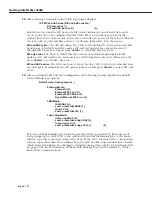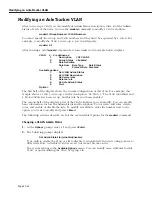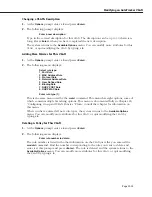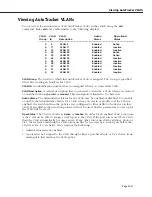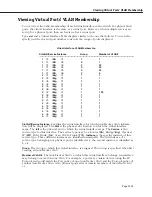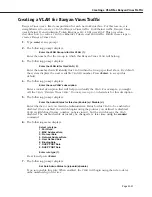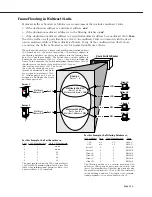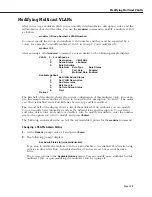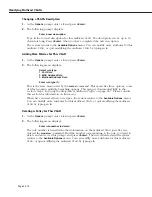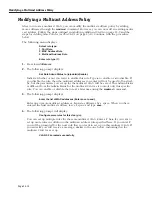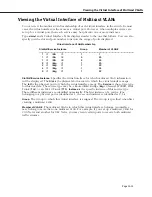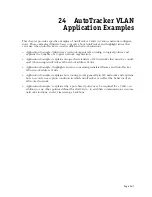
Page 23-2
How Devices are Assigned to Multicast VLANs
If the recipients of the multicast traffic were defined using the port rule, each specified port is
then marked as a member of the multicast
VLAN
.
If the recipients of the multicast traffic were defined using the
MAC
address rule to specify the
MAC
addresses of the receiving devices, no action is taken until a frame is received from one
of those devices. When such a frame is received, the switch learns the device, adds its
MAC
address to the filtering database, and marks the port on which the frame was received as a
member of the multicast
VLAN
. Note that the
MAC
address does not itself become a member
of the multicast
VLAN
, even though it is a recipient of the multicast traffic. Only ports are
members of multicast
VLAN
s.
When the switch receive multicast traffic that has an address specified as a multicast address
for the multicast
VLAN
, the traffic is switched to the ports defined as
VLAN
members.
♦
Please Take Note
♦
The source port of the multicast traffic (i.e., the port
through which multicast traffic enters the switch) can
be a member of any Group. The source port does
not
need to be a member of the same Group as recipient
ports. Note that the source port does not become a
member of the multicast
VLAN
.
Although some leakage may occur before devices are assigned to AutoTracker
VLAN
s, no
leakage occurs in conjunction with device assignment to multicast
VLAN
s.
♦
Please Take Note
♦
There is no default multicast
VLAN
. Unless you
explicitly create multicast
VLANs
, none will exist.
Multicast VLANs and Multicast Claiming
The goal of multicast claiming and multicast
VLAN
s is the same—to free the
MPX
module from
processing multicast traffic. Both methods off-load multicast traffic processing to the switch-
ing modules. However, multicast
VLAN
s can be seen as a refinement to multicast claiming.
Multicast claiming claims the
MAC
addresses of all source devices sending multicast traffic and
places those
MAC
addresses in the
CAM
s of all switching modules in a switch. Instead of
claiming all multicast traffic, multicast
VLAN
s claim only the traffic from the multicast address
you specify. In addition, this multicast address is only placed in the
CAM
s of switching
modules with destination ports that are part of the multicast
VLAN
.
Summary of Contents for Omni Switch/Router
Page 1: ...Part No 060166 10 Rev C March 2005 Omni Switch Router User Manual Release 4 5 www alcatel com ...
Page 4: ...page iv ...
Page 110: ...WAN Modules Page 3 40 ...
Page 156: ...UI Table Filtering Using Search and Filter Commands Page 4 46 ...
Page 164: ...Using ZMODEM Page 5 8 ...
Page 186: ...Displaying and Setting the Swap State Page 6 22 ...
Page 202: ...Creating a New File System Page 7 16 ...
Page 270: ...Displaying Secure Access Entries in the MPM Log Page 10 14 ...
Page 430: ...OmniChannel Page 15 16 ...
Page 496: ...Configuring Source Route to Transparent Bridging Page 17 48 ...
Page 542: ...Dissimilar LAN Switching Capabilities Page 18 46 ...
Page 646: ...Application Example DHCP Policies Page 20 30 ...
Page 660: ...GMAP Page 21 14 ...
Page 710: ...Viewing the Virtual Interface of Multicast VLANs Page 23 16 ...
Page 722: ...Application Example 5 Page 24 12 ...
Page 788: ...Viewing UDP Relay Statistics Page 26 24 ...
Page 872: ...The WAN Port Software Menu Page 28 46 ...
Page 960: ...Deleting a PPP Entity Page 30 22 ...
Page 978: ...Displaying Link Status Page 31 18 ...
Page 988: ...Displaying ISDN Configuration Entry Status Page 32 10 ...
Page 1024: ...Backup Services Commands Page 34 14 ...
Page 1062: ...Diagnostic Test Cable Schematics Page 36 24 ...
Page 1072: ...Configuring a Switch with an MPX Page A 10 ...
Page 1086: ...Page B 14 ...
Page 1100: ...Page I 14 Index ...

